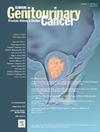Outcomes of Radical Radiotherapy for the Treatment of Localized Renal Pelvic and Ureteral Carcinoma Intolerant to Surgery: A Real-World Study
IF 2.3
3区 医学
Q3 ONCOLOGY
引用次数: 0
Abstract
Purpose
To investigate the safety and efficacy of radical radiotherapy for localized inoperable renal pelvic and ureteral carcinoma.
Methods
23 patients who received radiotherapy were enrolled. The prescribed dose was 60 to 67.5 Gy in 25 fractions and for bulky tumors, SABR was used in the first 3 to 5 times with tumor center boosted synchronously with 6 to 8 Gy/f. The Kaplan–Meier method was used to calculate local control (LC), DMFS, CSS and OS. Univariate analysis was performed by the log-rank test. The change in the eGFR before and after radiotherapy was compared by paired t test. The side effects were graded by CTCAE, version 5.0.
Results
The median follow-up time was 17 months. The LC rates at 2 years after radiotherapy were 85.0%; the DMFS rates were 52.2%; the CSS rates were 83.0%; and the OS rates were 77.8%. The main failure mode after radiotherapy was distant metastasis. Univariate analysis revealed that T3-4 stage (P = .001), N+ status (P < .001) and a tumor volume ≥ 20 cc (P = .005) were poor prognostic factors for DMFS. There was no significant difference in the mean eGFR before and after radiotherapy (47.0 mL/min/1.73m2 vs. 48.5 mL/min/1.73m2, P = .632). Only 1 patient developed acute grade 3 anemia. No patients developed grade 3 or higher late toxicities.
Conclusion
For localized inoperable renal pelvic and ureteral carcinoma, radiotherapy is well tolerable with high local control and expected to bring survival benefits. In such patients, radiotherapy may be an option when surgery is unsuitable.
放射治疗不耐受手术的局部肾盂和输尿管癌的疗效:真实世界研究
目的 研究根治性放疗对局部无法手术的肾盂和输尿管癌的安全性和有效性。规定剂量为 60 至 67.5 Gy,分 25 次进行,对于体积较大的肿瘤,前 3 至 5 次采用 SABR,肿瘤中心同步增强 6 至 8 Gy/f。采用 Kaplan-Meier 法计算局部控制率(LC)、DMFS、CSS 和 OS。单变量分析采用对数秩检验。放疗前后 eGFR 的变化采用配对 t 检验进行比较。结果中位随访时间为17个月。放疗后2年的LC率为85.0%;DMFS率为52.2%;CSS率为83.0%;OS率为77.8%。放疗后的主要失败模式是远处转移。单变量分析显示,T3-4分期(P = .001)、N+状态(P < .001)和肿瘤体积≥ 20 cc(P = .005)是DMFS的不良预后因素。放疗前后的平均 eGFR 无明显差异(47.0 mL/min/1.73m2 vs. 48.5 mL/min/1.73m2,P = .632)。只有 1 名患者出现急性 3 级贫血。结论对于局部无法手术的肾盂和输尿管癌,放疗具有良好的耐受性和较高的局部控制率,并有望带来生存益处。对于这类患者,如果不适合手术,放疗可能是一种选择。
本文章由计算机程序翻译,如有差异,请以英文原文为准。
求助全文
约1分钟内获得全文
求助全文
来源期刊

Clinical genitourinary cancer
医学-泌尿学与肾脏学
CiteScore
5.20
自引率
6.20%
发文量
201
审稿时长
54 days
期刊介绍:
Clinical Genitourinary Cancer is a peer-reviewed journal that publishes original articles describing various aspects of clinical and translational research in genitourinary cancers. Clinical Genitourinary Cancer is devoted to articles on detection, diagnosis, prevention, and treatment of genitourinary cancers. The main emphasis is on recent scientific developments in all areas related to genitourinary malignancies. Specific areas of interest include clinical research and mechanistic approaches; drug sensitivity and resistance; gene and antisense therapy; pathology, markers, and prognostic indicators; chemoprevention strategies; multimodality therapy; and integration of various approaches.
 求助内容:
求助内容: 应助结果提醒方式:
应助结果提醒方式:


